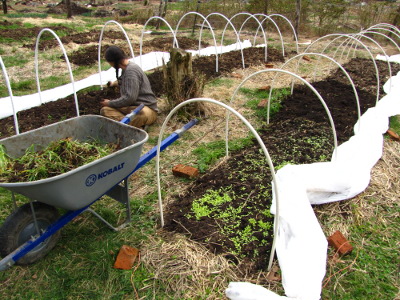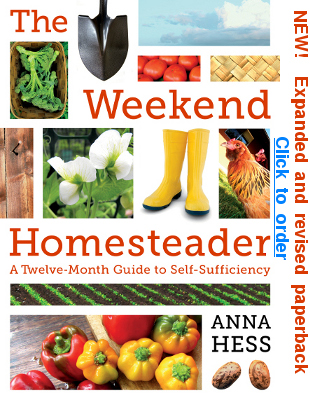
Preheating soil for the spring garden
 The
main difference between planting in early spring as opposed to
after the frost-free date is soil temperature --- cold ground makes
seeds rot before they sprout. Luckily, there are several methods
of heating up the soil, ranging from the simple to the complex.
The
main difference between planting in early spring as opposed to
after the frost-free date is soil temperature --- cold ground makes
seeds rot before they sprout. Luckily, there are several methods
of heating up the soil, ranging from the simple to the complex.
Add dark organic matter. You've probably noticed how wearing a black shirt in the sun heats your body up quickly. You can put the same science to work in the garden by topdressing your beds with a layer of dark-colored organic matter. Good compost, well-rotted manure, or even biochar can work. For more extreme soil preheating, you can lay down a dark sheet of plastic on the soil, but be aware that this technique can kill soil microorganisms.
 Erect a quick hoop. The
quick hoops you built in October are easy to move to a fresh plot
of
land to create mini-greenhouses on top of your spring beds.
Putting up a quick hoop a week or two before planting can warm the soil
by several degrees.
Erect a quick hoop. The
quick hoops you built in October are easy to move to a fresh plot
of
land to create mini-greenhouses on top of your spring beds.
Putting up a quick hoop a week or two before planting can warm the soil
by several degrees.
You probably noticed that each of these techniques shares two factors
--- sun and time. Your soil will naturally warm up as spring
advances; you're just trying to expedite the process so you can
jumpstart the garden year. To eat from your garden as soon as
possible, combine
all three methods and plant seeds as much as three months before your
frost-free date.
This
week's lunchtime series is
excerpted from Weekend
Homesteader: March. I saved some of my favorite
projects for last, so I hope you'll splurge 99 cents to read about
growing edible mushrooms, composting, and attracting native
pollinators. And, of course, the ebook has the full spring
planting
chapter in case you just can't wait to read each installment at noon
this week.
| This post is part of our Spring Planting lunchtime series.
Read all of the entries: |
Want more in-depth information? Browse through our books.
Or explore more posts by date or by subject.
About us: Anna Hess and Mark Hamilton spent over a decade living self-sufficiently in the mountains of Virginia before moving north to start over from scratch in the foothills of Ohio. They've experimented with permaculture, no-till gardening, trailersteading, home-based microbusinesses and much more, writing about their adventures in both blogs and books.
Want to be notified when new comments are posted on this page? Click on the RSS button after you add a comment to subscribe to the comment feed, or simply check the box beside "email replies to me" while writing your comment.
